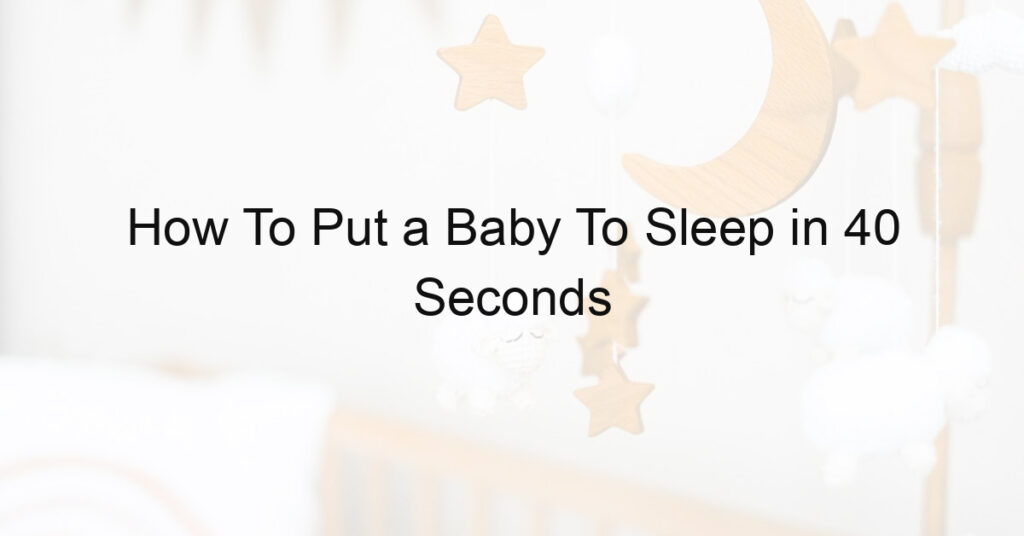Do you have a hard time getting your baby to sleep? Does it seem like no matter what you do, the minutes just keep ticking by without any success?
If so, we have some exciting news for you! With this simple, yet effective approach of putting your baby to sleep in 40 seconds or less, you can achieve that blissful state of quiet and rest that parents strive for.
By learning how to recognize your baby’s cues and incorporating soothing techniques, such as swaddling and white noise into their nighttime routine, we’ll show you how to help lull them off into dreamland in an efficient way.
So don’t wait any longer- let’s get started on getting a good night’s rest for everyone!
Tips for Putting Your Baby to Sleep in Less Than a Minute
Many new parents struggle with getting their baby to fall asleep. If you often find yourself frustrated as your infant cries, try some of these steps for a better experience.
Try holding your baby in your arms and swaying back and forth to a soft rhythm. You can also try singing a gentle lullaby or humming the same tune over and over until he or she starts to drift away into sleep.
The trick is not to make any sudden movements that could startle them awake so keep still until they are sound asleep. If you’re overwhelmed, don’t forget – patience is key and you can have your bundle of joy snoozing in no time!
Things to Avoid When Putting Your Baby to Sleep
Sleeping arrangements for your baby can be a minefield of potential danger. It is important to be aware of the risks associated with certain sleeping practices so you can ensure that your baby enjoys a safe, comfortable environment in which to sleep.
Things to avoid include putting a baby on their stomach while they sleep, using soft bedding and loose blankets, too many toys or pillows in the crib, and co-sleeping with pets or older siblings.
Instead, opt for a firm mattress covered in fitted sheets, dress your newborn lightly and use a suitable blanket tailored for their size and age. Following these simple steps will help ensure that your bundle of joy sleeps soundly knowing they are safe and warm.
The science behind baby sleep
From the moment a baby is born, their sleep schedule can become a great source of frustration for parents trying to understand it. To understand why every baby has such different sleep schedules and needs, it helps to know more about the science behind baby sleep.
Babies go through typical sleep states that are different than adults due to their unique stages of development, including light sleep and deep REM (Rapid Eye Movement) sleep.
Additionally, those patterns of deep and light sleeps tend to vary by age depending on when babies experience growth spurts and other physical developments like rolling over or teething.
Understanding this scientific background is key in helping parents gain insight into their baby’s individual sleeping needs.
The most consistent way to trigger tiredness
Sleep deprivation is perhaps the most consistent way to trigger feelings of tiredness. While occasional sleepless nights may not necessarily make a person feel overly exhausted, chronic deprivation of sleep can be very damaging for both physical and mental health.
Not only does it impair your focus and concentration, but it also decreases your ability to respond accurately in challenging situations. Even something as simple as driving on the highway can be significantly more dangerous if done while suffering from fatigue due to a lack of sleep.
In order to feel energized and alert throughout the day, an adequate amount of sleep should be incorporated into your daily routine.
How do you put a crying baby to sleep?
Knowing how to put a baby to sleep can seem like an intimidating task, but with some patience and response to your crying baby’s cues, it doesn’t have to be overwhelming.
Creating a soothing environment for your little one is key so dimming the lights in the bedroom may help. Comforting your baby with swaddling or rocking are also effective ways to demonstrate that you are present as they fall asleep.
Additionally, creating a predictability through consistent night time routines can also assist in putting a baby to sleep – perhaps they love hearing the same lullaby each night before bed!
Taking all of these factors into consideration and responding calmly to your baby’s cries will lead you down the path of success in helping them feel secure as they nod off into dreamland.
Conclusion
Putting your baby to sleep doesn’t have to be a long and grueling process. Taking advantage of the science behind sleep and creating relaxed bedtimes can help immensely.
Avoiding overstimulation, bright lights, and teething can also help in decreasing the amount of time spent trying to get them to sleep. With practice and patience you will soon be able to put your baby to sleep in less than a minute.
Provide enough stimulation during the day so that when night comes, your baby will naturally become tired and ready for bed. Have a thought out routine that is comfortable for both you and your baby- and stick with it!
This way, there won’t be any surprises come bedtime- making it easier for everyone involved. Remember that consistency is key! With it though, you will find comfort in knowing how to effectively unwind your little one into dreamland quickly – giving you more time for those precious moments with your family each night!














